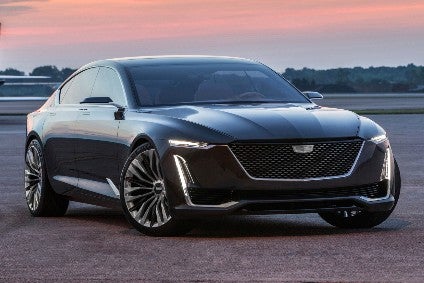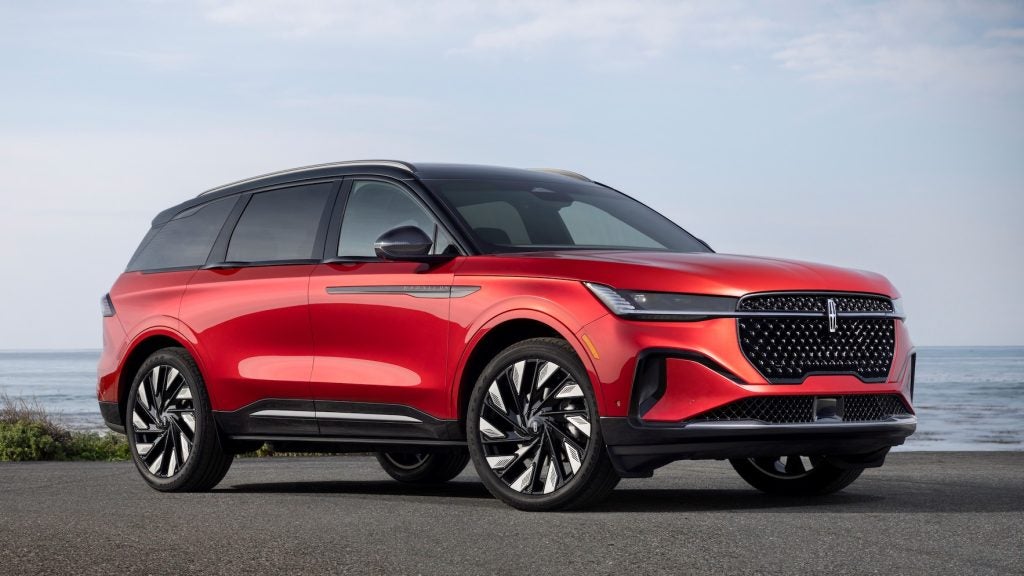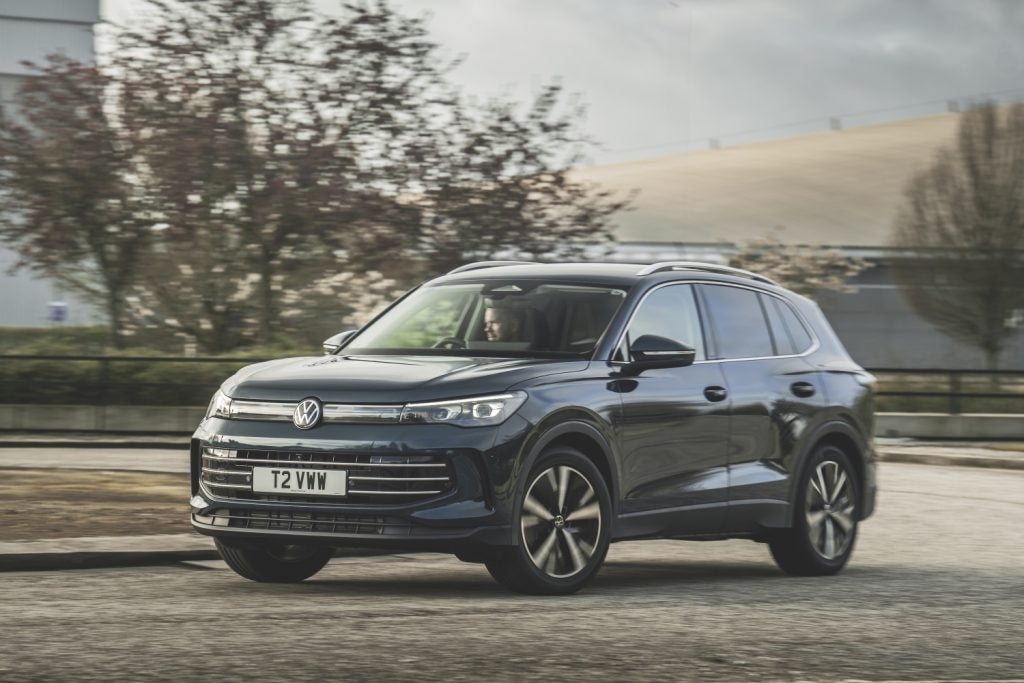
Cadillac cars and light trucks are the focus of the third feature in the series concerning the current and future vehicles of General Motors. This follows features on Baojun, Wuling, and Buick.
China and North America but where else?
How well do you really know your competitors?
Access the most comprehensive Company Profiles on the market, powered by GlobalData. Save hours of research. Gain competitive edge.

Thank you!
Your download email will arrive shortly
Not ready to buy yet? Download a free sample
We are confident about the unique quality of our Company Profiles. However, we want you to make the most beneficial decision for your business, so we offer a free sample that you can download by submitting the below form
By GlobalDataCan an automotive luxury brand be considered a global one if its reach into the mainstream is limited to only a handful of countries? In Cadillac’s case, the list of markets consists of a big two – China and the USA – plus a few smaller ones such as Canada and Mexico, and then multiple other minor-volume countries in Europe and the Middle East.
Division president Johan de Nysschen is on the record as stating that European markets are not a priority, though he does expect to see an expansion of sales in the region once certain future powertrains come on line. For now, China is what matters most, especially as the average age of buyers there is close to 30, a dream position for Cadillac to be in. India also has a lot of young people and in contrast to the PRC, the overall population is rising. RHD markets in Asia and Asia-Pac are, however, not a priority.
Production of Cadillacs is steadily increasing in China, and the brand is fortunate enough to have been singled out by the SAIC GM joint venture to receive both the latest tech in certain models, plus the most modern factory for their build. A plug-in version of the large CT6 sedan is not only selling well locally, thus improving the brand’s image even further amongst the young, but the car is also exported to North America.
Johan de Nysschen would obviously love to have many more SUVs in the Cadillac line-up so as to get the brand onto the consideration lists of those looking at small and compact sized SUVs such as the Audi Q2, Q3 as well as all those people who continue to buy ever greater numbers of the A3 sedan. GM is giving Cadillac a lot more product than it has had in the past, so things do seem poised to move ever upwards from the perspective of total worldwide sales.
China overtakes the USA
Of the roughly 309,000 vehicles delivered in 2016, the majority were for the first time sold to buyers in China, that market overtaking the US during the last month of the year. This trend has continued, with global volume for the first quarter of CY2017 reaching 78,649 units, a year-on-year gain of 28.6 per cent. Of that total, China accounted for 39,414 vehicles with the US market contributing 33,982. Canada took 2,623 cars, the Middle East 957 and Cadillac’s Rest Of World region having 1,673 units. GM has kept the brand out of India and it appears that it sees no potential opportunity in the immediate future.
That Cadillac has been as successful as it now is with such a small portfolio of vehicles is testament to their quality. The line-up will be stretched at both ends in the coming years as well as being filled in at several size points, especially when it comes to SUVs. The range of electrified vehicles is also fairly limited right now, however, quite a few more are under development.
The addition of so many additional vehicles between now and the early 2020s should catapult Cadillac to a record global sales level. The division’s highpoint was touched way back in 1980. That year, some 360,000 Caddys were retailed, mainly in the USA. If overall trends continue, the contribution of China should guarantee the setting of a new record for annual worldwide deliveries relatively soon. It is also well within the realms of possibility to see Cadillac pushing past the half-million mark, potentially within a few years: the production capacity for that to happen already exists or can be added without the need for massive spending on new plants.
Cars
A C segment/Compact car has been looked at time and again by GM. The Cimarron compact from the 1980s was less than well received by the market and remains an infamous model which the company would rather forget.
The world has moved on a long way since the days of GM’s first J cars. So too has Cadillac. The division could certainly do with a rival for the Mercedes-Benz CLA-Class but the question remains, would there be enough demand in just China and North America for a proposed Cadillac CT2 or CT3? In theory, it could share the rear/all-wheel drive Alpha platform of the ATS and be manufactured at the Lansing Grand River plant in Michigan.
The most compact of Cadillac’s existing cars is the Mid-size/D segment ATS range. This is available with two or four doors and both cars are manufactured in Michigan. GM’s intention was to create rivals for the BMW 3 Series Sedan and 4 Series Coupe.
The ATS sedan was the first vehicle for GM’s rear- and all-wheel drive Alpha platform. The car’s global debut was at the Detroit motor show in January 2012 and production commenced at Lansing Grand River plant six months later. A new GM engine was launched in the ATS: a 198kW (270hp) turbocharged 2.0-litre four-cylinder. In certain markets, such as Canada, the ATS is also available with a normally aspirated 2.5-litre four-cylinder engine and/or a 3.6-litre V6.
The RWD/AWD ATS Coupe was first seen at the Detroit auto show in January 2014, going on sale six months later for North America’s 2015 model year. The standard engine was originally the 2.0-litre turbo as the sedan, with a 321hp 3.6-litre V6 optional. The latter was replaced by a 333hp V6 of the same size for the 2016 model year.
A high performance ATS-V Coupe was a world premiere at the LA auto show in November 2014. An ATS-V sedan was revealed at the same event. These are powered by a 339kW (455hp) 3.6-litre biturbo V6 and were the main news for the 2016 model year.
A China-built long wheelbase variant of the ATS sedan went on sale there in August 2014. What is now known as the SAIC GM joint venture (formerly Shanghai GM) began importing the US-made ATS in November 2013. This remains on sale alongside the ATS-L which is made in Shanghai.
The 2018 model year ATS Sedan and Coupe should be facelifted with these cars possibly to debut at the LA auto show in the fourth quarter.
The ATS range will not be directly replaced, Cadillac president Johan de Nysschen stated in an interview at the 2015 New York auto show. Production of the current sedan and coupe will probably cease during CY2020 or 2021.
The third generation CTS shifted segments and became a similarly sized (and priced) rival for the BMW 5 Series. The car is five inches longer, the roofline is an inch lower and it is said to be seven percent lighter than the previous generation sedan. The CTS had its global debut at the New York auto show in March 2013. Production is alongside the ATS sedan and ATS coupe at GM’s Lansing Grand River plant in Michigan.
The Cadillac CTS sedan reached US showrooms from October 2013 for North America’s 2014 model year. It is also available with GM’s 410hp 3.6-litre biturbo V6 engine. This is standard on the CTS vSport, which comes in two trim levels: Premium or Platinum. Mitsubishi Heavy Industries supplies the turbocharger for the twin-turbo engine which is produced at a GM plant in Mexico.
The CTS has an eight-speed automatic gearbox supplied by Aisin Seiki. The base engine is a 272hp 2.0-litre turbocharged four-cylinder unit. In addition to the biturbo derivative, a normally aspirated 3.6-litre V6 is also available. A new 3.6-litre V6 was part of mechanical changes for North America’s 2016 model year.
GM China, which began imports of the new model in early 2014, said at that time that it would not build or assemble the car.
The CTS-V had its world premiere at the Detroit auto show in January 2015. It was new for North America’s 2016 model year. The engine for this derivative is a 640hp supercharged 6.2-litre V8. A top speed of 200mph made this the fastest Cadillac yet. The V has a carbon fibre bonnet. Production commenced in mid-2015.
A facelift should be part of 2018 model year changes. The CTS will not be directly replaced, Cadillac president Johan de Nysschen stated in an interview at the 2015 New York auto show.
The Ciel, a huge four-door convertible concept, which premiered at the Pebble Beach Concours d’Elegance in August 2011, previewed some of the styling of the CT6. The same applies to the Elmiraj, a big two door concept which had its public debut at the 2013 Pebble Beach Concours. GM said the design study was powered by a 500+hp 4.5-litre biturbo petrol V8. Prior to the September 2014 announcement of the CT6 model name, both LTS and WTS were believed to have been likely names.
This big sedan is eight inches longer than a CTS sedan but weighs slightly less. The ‘6’ in the name is said to mean that it is sized between the BMW 5 Series and 7 Series sedans. It sits in Cadillac’s range above the XTS. A pre-production CT6 had its worldwide debut at the New York auto show in April 2015.
The CT6 shares some modules of its rear- and all-wheel drive architecture with the Alpha platform ATS and CTS but this was the first car for GM’s Omega architecture. Production at Detroit Hamtramck commenced in late 2015. The car is also made in China by SAIC GM, with the Pudong plant the only one of the CT6 factories to be building the plug-in hybrid variant (see section on EVs and PHEVs below).
There are three petrol engines, each turbocharged (2.0-litre, 3.0-litre and a biturbo 3.6-litre), plus the PHEV powertrain. The car will not be offered with diesel engines before 2019, Johan De Nysschen stated in February 2015. The brand’s CEO told the media in August 2015 that diesel engines would be part of Cadillac’s future in North America, Europe and elsewhere.
The addition of the CT6 saw GM add a second shift to its Hamtramck plant in Michigan. This increased the plant’s workforce to about 2,800. As well as the big Cadillac, the plant was already building the Chevrolet Volt, Impala and Malibu; plus the Cadillac ELR, on a single production line.
There should a facelift for the 2020 model year with a second generation CT6 following in CY2023.
The XTS is intended to be rival for the Audi A6. It is, however, a far larger car, being similarly sized to the A8. The big sedan replaced two cars in North America: US production of the DTS and STS sedans ended in the second quarter of 2011. The SLS, which was a long wheelbase derivative of the former STS for China’s Shanghai GM joint venture, was phased out in early 2013. A locally-built version of the XTS went on sale in China in February 2013 and was the effective successor to the SLS.
The XTS had its global debut at the Los Angeles auto show in November 2011. GM Canada began building it at Oshawa in February 2012. Later the same month, GM revealed an XTS Town Car at the International LCT (Limousine, Charter and Tour) Show at the MGM Grand in Las Vegas. This variant, known as the XTS W20 Livery Sedan Package, previewed the extended-wheelbase and sedan chassis cars which began to be made from late 2012. In August 2012, GM also issued images of a hearse variant, which is made by an external specialist firm, as is the stretched sedan.
The world premiere in prototype form took place at the 2011 Detroit motor show as the XTS Platinum concept. This vehicle, which was said to have all-wheel drive, was a plug-in hybrid. GM claimed it could run on either its 3.6-litre gasoline V6 or an electric motor. The concept’s quoted wheelbase dimension, 2,837mm, was identical to that of the Saab 9-5 and Buick LaCrosse but far shorter than that of the Cadillac DTS and STS.
The launch engine for North America was a 224kW (300hp) 3.6-litre V6 in combination with a six-speed automatic gearbox. The XTS went on sale in North America in May 2012 for that region’s 2013 model year. The 3.6-litre biturbo V6 which premiered at March 2013’s New York auto show was added to the XTS from October 2013. It was an addition for the 2014 model year in a new variant, the XTS vSport.
There were only minor changes for North America’s 2015 and 2016 model years. An expected facelift for the 2017 model year did not materialise. Instead there were just small changes. A facelift was announced for the 2018 XTS in June 2017.
The XTS will not be directly replaced, Cadillac president Johan de Nysschen stated in an interview at the New York auto show in April 2015. That also means that the brand may eventually withdraw from the funeral car and stretched limousine/livery market. The XTS should remain in production until eventually being phased out in 2019. The CT6 can be thought of as its effective replacement.
The CT7 is not yet confirmed for production but such a model was previewed by the Escala concept at the 2016 Pebble Beach Concours d’Elegance (see pic). The Escala was a 5,347mm long hatchback in the style of the Porsche Panamera. It was powered by the biturbo 4.2-litre V8 which GM is developing for the CT6.
Should the CT7 be signed off for production, it is likely to be manufactured at Hamtramck in Michigan from late 2019. The architecture should be an evolution of today’s Omega, which is RWD and AWD.
Johan De Nysschen told an interviewer at the Paris motor show in October 2014 that a rival for long-wheelbase versions of the Mercedes-Benz S-Class and BMW 7 Series had been signed off for development. It had been due to appear at the end of the decade and would be called CT8 or CT9, he added. It is now thought that this project has been shelved. Cadillac’s president likely sees that there is now more opportunity in the large SUV segment. The level of spending for GM to come up with a true rival for the Mercedes-Benz S-Class, BMW 7 Series, Audi A8 and Lexus LS would surely make the business case for a CT8/CT9 difficult to make.
Crossovers & SUVS
XT2, which may instead be called XT3, would be related to the CT2 sedan, the proposed rival for the Mercedes-Benz CLA-Class. The Compact/C segment SUV would challenge the Mercedes-Benz GLA-Class, BMW X1, Audi Q3, Volvo XC40 and Infiniti XC30.
This vehicle could be the model which GM stated in June 2015 that it was planning to build at its Orion Township plant. However, these plans changed, with another announcement in April 2016 stating that the investment for Orion Township would instead be going into Kansas City.
If General Motors decides to keep selling Cadillacs in European countries, a diesel XT2/XT3 is also expected. This might not appear until 2020, some eighteen months after the SUV’s arrival in North America and China.
GM engineers are also said to be working on a Cadillac rival for the BMW X3 and Audi Q5. Such a vehicle would logically be closely linked to the Buick Envision and Opel Grandland. Cadillac’s CEO stated at the 2015 LA auto show that an SUV smaller than the XT5 would be on sale in 2018. The model name should be XT4.
Like the new Range Rover Velar, the XT5 is a 4.8m long SUV. GM confirmed in August 2014 that its SRX replacement would be built in the US at the former Saturn plant at Spring Hill from late 2015. In July 2013, the company said it would increase to US$350 million planned spending for new vehicles to be produced at the Tennessee assembly plant. The additional investment added $167 million to a previously announced $183 million pledge. The second generation GMC Acadia is built in the same plant as the closely related Cadillac XT5.
The XT5 (Crossover Touring 5) had its world premiere at the Dubai motor show in November 2015, before being displayed in the US for the first time at the LA show later the same month. Production would commence in the US and China in spring 2016, GM told the media in November 2015.
Cars for the US are powered by a 3.6-litre V6. The XT5 for China is built by the SAIC GM joint venture and has a turbocharged four-cylinder 2.0-litre engine. An eight-speed automatic is standard for both engines. Depending on the market, both front-wheel drive and all-wheel drive variants are available. The 2.0-litre engine might eventually be offered in North America’s XT5.
Cadillac Europe stated in November 2015 that the XT5 would be on sale in its region in summer 2016. It went on sale there in July 2016. There is no right-hand drive build.
The XT5 should be facelifted in late 2019. The second generation would logically use an update of the current model’s C1xx architecture.
XT6 is yet another future, additional crossover. It should share much with the XT5. The model name might instead be XT7, with some sources indicating this could be a rebodied, long-wheelbase XT5 which has seven seats. As such, it would go up against the BMW X7, Mercedes-Benz GLS-Class and Range Rover Sport. The release of this model should be in October 2018, a few months ahead of its BMW rival.
GM revealed the current shape Escalade to the media in October 2013. This, the brand’s largest SUV, was new for North America’s 2015 model year, with production commencing in the spring of 2014. One unusual feature is a centre-mounted airbag in the front, which is needed due to the sheer width of the cabin.
The product line consists of the standard Escalade, as well as the extended-length Escalade ESV, which offers a 14-inch-longer (355mm) wheelbase and approximately 20 inches (508mm) more in overall length. As well as additional room for third-row passengers, the ESV has 60 per cent more cargo space behind the third-row seat.
Both RWD and 4WD variants are available, all powered by a 420hp (313kW) 6.2-litre V8. A Hydra-Matic 6L80 six-speed automatic transmission with enhanced TapShift control was originally standard but replaced by the eight-speed 8L90.
A facelift is due for the 2018 model year.
As the Escalade name is so well known, this model will not change names and become an XT-number: i.e. the SRX was replaced by the XT5.
The Escalade and ESV replacements are expected to enter production during the third quarter of 2021.
GM is reported to be planning to make the next models more expensive and true rivals for the next generation Range Rover and Range Rover L.
EVs & PHEVS
A replacement for the ELR 2+2 coupe would again be a plug-in car but other than that, it should have major changes compared to its unsuccessful predecessor. Sales were slow, due in part to a high price. A mere 1,310 were delivered to US customers in 2014 and only 1,024 in 2015. Production was stopped in February 2016.
Speaking at the Paris motor show in October 2014, Cadillac president Johan De Nysschen said the ELR successor would be a pure plug-in, whereas the short-lived coupe used the same range-extending powertrain as the first generation Chevrolet Volt.
Since De Nysschen spoke to the media on the topic of a new plug-in model, Cadillac and GM are said to have looked again at the potential of an EV and revised their plans. The future electric Cadillac should be a crossover-SUV and a competitor for the Jaguar I-PACE, Audi e-tron and an EQ model from Mercedes-Benz. Production might be as soon as 2019 though 2020 has also been suggested by sources.
Coming much sooner than a fully electric Cadillac is an XT5 PHEV. The petrol-electric plug-in hybrid will be built only in China but it might be exported to the USA. GM China is expected to name this model ‘XT5 Plug-In’ or XT5 30E. It should have a lower output version of the 2.0-litre turbo and electric motor powertrain which was first seen in the CT6 Plug-In. Production is due to commence in November, sources report.
Given its sheer size, 5,182mm long PHEV version CT6 is as a rival for the Mercedes-Benz S 500 e (S550e in North America).
The CT6 PHEV had its world premiere at the Shanghai motor show in April 2015 and went on sale in China in January 2016. It has combined power of 250kW (335hp) from two electric motors and its turbocharged 2.0-litre four-cylinder petrol engine. An 18.4 kWh LG Chem lithium-ion battery pack is located between the rear seat and the boot. The battery system is comprised of 192 prismatic pouch cells. Combined torque is quoted as 580Nm (432 lb-ft). The Chinese market name can also be CT6 Plug-In.
GM China builds the plug-in hybrid version of the CT6 and exports it to the US and other countries. The car is manufactured at GM and SAIC’s second Cadillac plant. The 477,000-square-metre facility has an annual capacity of 160,000 units. The plant includes a body shop, a paint shop, a general assembly shop, a high-speed test track and auxiliary facilities.
The CT6 PHEV was new for North America’s 2017 model year, the car going on sale there in March 2017. There should be a facelift in 2019 and a replacement in 2023. That car might be fully electric or there might be both EV and PHEV derivatives.
Will there be a hydrogen-powered Cadillac?
General Motors is well recognised as one of the long-time advocates of the potential of fuel cell vehicles. Prototypes have been tested over decades, with Chevrolet and Opel two of the brands which have had hydrogen-fuelled fleets out in the real world.
More than seven years ago – March 2010 to be exact – General Motors stated that it was working on a fuel cell stack that could be ready for series production in 2015. This followed the company building 119 prototype Chevrolet or Opel-badged Equinox fuel cell vehicles for testing in North America and Europe as part of Project Driveway.
GM most recently stated that its latest design weighs 220lb less than the fuel cell in the Equinox, is half the size (now comparable to a four-cylinder engine) and needs only one third of the amount of platinum to operate.
In July 2013, General Motors and Honda issued a statement which said they had signed an agreement to collaborate for what was termed “a long-term, definitive master agreement to co-develop next-generation fuel cell system and hydrogen storage technologies, aiming for the 2020 time frame”.
The statement went on to add: “The collaboration expects to succeed by sharing expertise, economies of scale and common sourcing strategies”. The collaboration is believed to mean a GM fuel cell vehicle will be delayed until 2020.
In January 2017, GM and Honda announced that their co-developed fuel cells would be manufactured at a plant in Michigan from 2020. Things are still moving forward, a logo for the JV having just been announced.
The March 2017 announcement of Groupe PSA’s purchase of Opel-Vauxhall included a statement on fuel cell vehicles. The JV with Honda will not only continue but PSA will have access to the venture. It is now believed that on the GM side of this JV, either Chevrolet or Cadillac will instead be the brand for GM’s fuel cell model.
Given that both Honda and Toyota chose to make their limited production Clarity and Mirai models large sedans, GM might well specify an SUV body style for could become a Cadillac FCV. Toyota Motor is also said to be working on a hydrogen-powered electric Lexus and this is believed to be based on the soon to be released LS sedan. Due to be in limited production for the 2020 Tokyo Olympic Games, this Lexus and a theoretical different take from Cadillac on how fuel cell vehicles can look might be enough to properly jump start interest in hydrogen. For now, only California and a few other parts of the world are where limited-production Hondas, Hyundais and Toyotas can be (rarely) seen, humming along, daring not to stray too far from a small number of refuelling stations.
Future model plan reports for other manufacturers can be viewed in the OEM product strategy summaries section of just-auto.com.
Future product program intelligence
Additional data on vehicle lifetime and future product plans, such as code names, production plants and expected annual build, are available in PLDB from QUBE.








